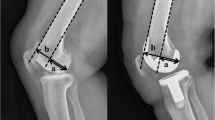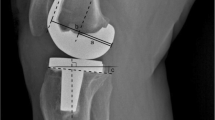Abstract
Background
Anterior tibial translation associated with posterior impingement has been reported to be one of the factors limiting flexion after posterior cruciate-retaining (CR) total knee arthroplasty (TKA), especially when posterior condylar offset is decreased postoperatively. On the other hand, its effect on postoperative motion in posterior-stabilized (PS) TKA remains unknown. It has been demonstrated that PS TKA exhibits a consistent posterior femoral rollback during flexion. Thus, we hypothesized that the problem of posterior impingement can be avoided by use of PS TKA. In this study, we examined the relationship between postoperative posterior condylar offset and knee flexion in CR and PS TKAs.
Methods
In this study, analysis was performed for 20 subjects who underwent bilateral TKAs (one CR and one PS TKA) as well as another group of 50 PS TKAs. All patients could be tracked for a minimum of 2 years. The range of flexion was measured before operation and at follow-up. Preoperative and postoperative posterior condylar offset was evaluated on true lateral radiographs.
Results
At the follow-up examination, the mean flexion angle was 123° in the CR knees and 131° in the PS knees with a significantly greater improvement observed for the latter group. In the roentgenographic measurement of the posterior condylar offset, no significant difference was observed between the preoperative and postoperative values both in the CR and PS knees. We divided the patients into two groups according to the change of posterior condylar offset. The first group (Group I) showed a decrease in the posterior condylar offset after surgery and the second group (Group II) showed no change or an increase. Subsequently, postoperative change in flexion was compared between Groups I and II for the CR and PS knees. A significant difference between Groups I and II was observed in the CR knees, while no difference was observed in the PS knees. The magnitude of postoperative posterior condylar offset did not correlate with an improvement in maximum flexion angle in the 50 PS knees.
Conclusions
It was shown that the magnitude of posterior condylar offset correlated with a postoperative change in flexion angle in CR knees, while no such correlation was observed in PS knees.
Similar content being viewed by others
References
Anouchi YS, McShane M, Kelly F Jr, Elting J, Stiehl J. Range of motion in total knee replacement. Clin Orthop 1996;331:87–92.
Chiarello CM, Gundersen L, O’Halloran T. The effect of continuous passive motion duration and increment on range of motion in total knee arthroplasty patients. J Orthop Sports Phys Ther 1997;25:119–127.
Dennis DA, Komistek RD, Stiehl JB, Walker SA, Dennis KN. Range of motion after total knee arthroplasty: the effect of implant design and weight-bearing conditions. J Arthroplasty 1998;13:748–752.
Hirsch HS, Lotke PA, Morrison LD. The posterior cruciate ligament in total knee surgery. Save, sacrifice, or substitute? Clin Orthop 1994;309:64–68.
Maloney WJ, Schurman DJ. The effects of implant design on range of motion after total knee arthroplasty. Total condylar versus posterior stabilized total condylar designs. Clin Orthop 1992;278:147–152.
Papagelopoulos PJ, Sim FH. Limited range of motion after total knee arthroplasty: etiology, treatment, and prognosis. Orthopedics 1997;20:1061–1065.
Ryu J, Saito S, Yamamoto K, Sano S. Factors influencing the postoperative range of motion in total knee arthroplasty. Bull Hosp Joint Dis 1993;53:35–40.
Shoji H, Yoshino S, Komagamine M. Improved range of motion with the Y/S total knee arthroplasty system. Clin Orthop 1987;218:150–163.
Stiehl JB, Voorhorst PE, Keblish P, Sorrells RB. Comparison of range of motion after posterior cruciate ligament retention or sacrifice with a mobile bearing total knee arthroplasty. Am J Knee Surg 1997;10:216–220.
Banks SA, Markovich GD, Hodge WA. In vivo kinematics of cruciate-retaining and-substituting knee arthroplasties. J Arthroplasty 1997;12:297–304.
Dennis DA, Komistek RD, Hoff WA, Gabriel SM. In vivo knee kinematics derived using an inverse perspective technique. Clin Orthop 1996;331:107–117.
Kim H, Pelker RR, Gibson DH, Irving JF, Lynch JK. Rollback in posterior cruciate ligament-retaining total knee arthroplasty. A radiographic analysis. J Arthroplasty 1997;12:553–561.
Stiehl JB, Dennis DA, Komistek RD, Keblish PA. In vivo kinematic comparison of posterior cruciate ligament retention or sacrifice with a mobile bearing total knee arthroplasty. Am J Knee Surg 2000;13:13–18.
Victor J, Banks S, Bellemans J. Kinematics of posterior cruciate ligament-retaining and-substituting total knee arthroplasty: a prospective randomised outcome study. J Bone Joint Surg Br 2005;87:646–655.
Maruyama S, Yoshiya S, Matsui N, Kuroda R, Kurosaka M. Functional comparison of posterior cruciate-retaining versus posterior stabilized total knee arthroplasty. J Arthroplasty 2004;19:349–353.
Insall JN, Dorr LD, Scott RD, Scott WN. Rationale of the Knee Society clinical rating system. Clin Orthop 1989;248:13–14.
Komistek RD, Scott RD, Dennis DA, Yasgur D, Anderson DT, Hajner ME. In vivo comparison of femorotibial contact positions for press-fit posterior stabilized and posterior cruciate-retaining total knee arthroplasties. J Arthroplasty 2002;17:209–216.
Yoshiya S, Matsui N, Komistek RD, Dennis DA, Mahfouz M, Kurosaka M. In vivo kinematic comparison of posterior cruciate-retaining and posterior stabilized total knee arthroplasties under passive and weight-bearing conditions. J Arthroplasty 2005;20:77–83.
Bellemans J, Banks S, Victor J, Vandenneucker H, Moemans A. Fluoroscopic analysis of the kinematics of deep flexion in total knee arthroplasty. Influence of posterior condylar offset. J Bone Joint Surg Br 2002;84:50–53.
Banks S, Bellemans J, Nozaki H, Whiteside LA, Harman M, Hodge WA. Knee motions during maximum flexion in fixed and mobile-bearing arthroplasties. Clin Orthop 2003;410:131–138.
Author information
Authors and Affiliations
About this article
Cite this article
Arabori, M., Matsui, N., Kuroda, R. et al. Posterior condylar offset and flexion in posterior cruciate-retaining and posterior stabilized TKA. J Orthop Sci 13, 46–50 (2008). https://doi.org/10.1007/s00776-007-1191-5
Received:
Accepted:
Published:
Issue Date:
DOI: https://doi.org/10.1007/s00776-007-1191-5




